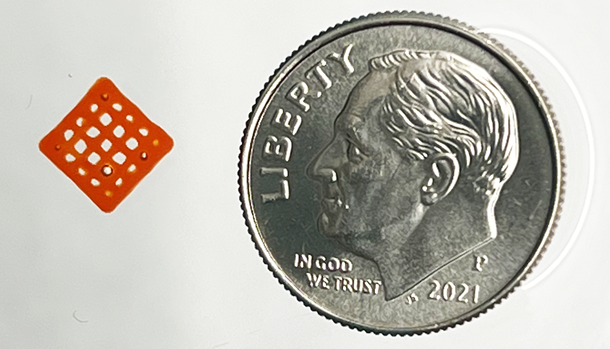With 3D printing becoming a key fabrication strategy for biomedical research, researchers at the lab of Jeffrey Hartgerink at Rice University have shown proof of concept for 3D-printing structures for housing human cells using self-assembling peptide ink. The breakthrough could lead to improvements in the development of cell scaffolds for growing tissue, as well as in regenerative medicine and medical research.
As reported in Advanced Materials [Farsheed et al. Adv. Mater. (2023) DOI: 10.1002/adma.202210378], the well-defined but complex structures that house cells were built using multidomain peptides (MDPs) as the base material for the 3D-printing inks. The MDPs are a class of self-assembling peptides that form a nanofibrous hydrogel at low concentrations. As they were designed to be hydrophobic on one side and hydrophilic on the reverse, on being placed in water one molecule will flip on top of another to make what they term “a hydrophobic sandwich”. The stacked peptides make long fibers that form a hydrogel. – although synthesized in the lab, they are biologically relevant since they are only composed of naturally occurring amino acids with biologically familiar chemistries.
The structures were printed with either positively charged or negatively charged MDPs, with immature muscle cells placed on the structures acting differently depending on the charge. Cells were shown to stay balled up on the substrate for a negative charge, while they spread out and started to mature on the positively charged material.
The material was shown to reassemble after deformation. On more material being added, the extra concentration was increased about fourfold, and worked very well. The aim is to be able to print structures with cells and grow mature tissue in a petri dish so the tissues can then be transplanted for treating injuries, or studying how illnesses work and to test drug candidates.
New hydrogels with desirable biological properties are needed in 3D-printable inks, and here the printability of MDPs was established, as was their optimization with different charge functionalities as distinct inks to create complex 3D structures. As lead author Adam Farsheed told Materials Today, “We believe we have demonstrated a new class of inks that has the advantages of synthetic materials in that they are chemically pure, reducing batch-to-batch variability but are biointeractive in a way that only biologically derived materials generally have been.”
Although the research mainly serves as a proof of concept, the team hope there will be a variety of future in vitro and in vivo applications, and also in hydrogel 3D printing to introduce what self-assembling peptides are and how they can be leveraged in new ways for 3D printing inks.
“We believe we have demonstrated a new class of inks that has the advantages of synthetic materials in that they are chemically pure, reducing batch-to-batch variability but are biointeractive in a way that only biologically derived materials generally have been.”Adam Farsheed
 Structures printed using the peptide-based 3D-printing ink (a dime is included for scale)
Structures printed using the peptide-based 3D-printing ink (a dime is included for scale)